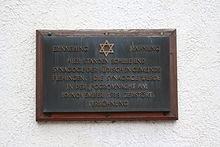Jewish community of Flehingen
A Jewish community in Flehingen , a district of the community of Oberderdingen in northern Baden-Württemberg , has been recorded since the 16th century. The community had its largest membership in 1832 with 167 people (14% of the total population), then gradually became smaller through emigration and emigration and became extinct at the time of National Socialism .
history
Jews are first recorded in Flehingen in 1548. After the turmoil of the Thirty Years' War , the landlord Wolff-Metternich took in Jews again. Their number was limited to ten families in Flehingen at the end of the 17th century. In 1688 the Jewish cemetery in Flehingen was laid out on Gochsheimer Strasse. In the 18th century the first synagogue was built, which was used until 1874 and whose building has been preserved as the Old Synagogue to this day .
The Jewish community, to which the Jews in Sickingen and until 1900 also the Jews in Bauerbach belonged, was assigned to the Bretten district rabbinate in 1827 . In Flehingen itself there were 160 members of the Jewish community, making it the largest Jewish community in the Bretten district office . Essentially only two Jewish families lived in Sickingen. In Bauerbach however, there were around 1825 already about 70 Jews who own synagogue and a private mikveh had. Most of the Jews from Bauerbach emigrated to nearby Bretten before 1900, so that the Bauerbach community dissolved in 1894. The synagogue there was converted into a residential building.
In the 19th and 20th centuries, the Jewish families lived mainly from the cattle trade or had shops, in Bauerbach mainly butchers. Their residential area in Flehingen was concentrated in the Hinterdorf , also known as Judengasse , today Samuel-Friedrich-Sauter- Strasse. From 1918 to 1933 there were five Jewish associations in Flehingen: Israelite women’s association (support for those in need, burial), Israelite women and girls group Agudas Israel (1918), Israelite men’s association (burial) and Talmudic course ( reading Shiur on the Sabbath ).
In 1874 a new synagogue was built in Flehingen. It was completely destroyed in the November pogrom in 1938 and broken up in 1940.
National Socialist Persecution
Of the 59 Jewish fellow citizens living in Flehingen in 1933, at least 17 died as a result of National Socialist persecution .
The memorial book of the Federal Archives lists 42 Jewish citizens born in Flehingen who fell victim to the genocide of the National Socialist regime .
For many murdered Jews from Flehingen , stumbling blocks were laid in recent years on the initiative of the advanced history course of the Melanchthon grammar school in Bretten .
Personalities
- The most important Jewish personality from Flehingen was Jakob Barth (1851–1914), one of the most famous orientalists of his time.
- Lazarus Schlessinger (born 1842/43 in Flehingen; died in July 1924 there), district rabbi in Bretten.
- Simons Lazarus Flegenheimer (born around 1723 in Flehingen; died on May 8, 1793 in Darmstadt), regional rabbi in Mühringen and Darmstadt.
- Isak Flehinger (born 1736; died on April 25, 1818 in Flehingen), son of Veit Flehinger and married to Kela Flehinger. Isak Flehinger was a knightly regional rabbi in Flehingen from around 1768 until his death in 1818, with responsibility for the Jewish community of Flehingen and the neighboring communities.
- Veit Flehinger (born on July 12th, 1769 in Flehingen; died on December 25th, 1854 in Bretten), son of Isak Flehinger, district rabbi in Bretten.
- Baruch Hirsch Flehinger (born 1809 in Flehingen; died 1890), district rabbi in Merchingen.
Community development
| year | Parishioners |
|---|---|
| 1734 | 14 people |
| 1832 | 167 people |
| 1844 | 158 people |
| 1871 | 132 people |
| 1887 | 141 people |
| 1900 | 144 people |
| 1910 | 107 people |
| 1924 | 86 people |
| 1933 | 72 people |
literature
- Karl Banghard : The Jews in Flehingen - An active minority , in: Five snow balls, twelve centuries - Flehingen-Sickingen 779 to 1979 , Karlsruhe 1979, p. 147-184.
- Joachim Hahn and Jürgen Krüger : Synagogues in Baden-Württemberg. Volume 2: Joachim Hahn: Places and Facilities. Konrad Theiss Verlag , Stuttgart 2007, pp. 354–357, ISBN 978-3-8062-1843-5 ( Memorial Book of Synagogues in Germany. Volume 4).
- Berthold Rosenthal : Homeland history of the Baden Jews from their historical appearance to the present , Bühl 1927 (Reprint: Magstadt bei Stuttgart 1981, ISBN 3-7644-0092-7 ).
- Michael Brocke and Julius Carlebach (editors), edited by Carsten Wilke : Biographisches Handbuch der Rabbis. Part 1: The rabbis of the emancipation period in the German, Bohemian and Greater Poland countries 1781–1871. K G Saur, Munich 2004, z. BS 311ff.
- Wolfgang Schönfeld: Fates of Jewish families in Flehingen. Verlag Alte Uni, Eppingen 2013, ISBN 978-3-926315-42-7 (not evaluated).
Web links
Individual evidence
- ^ Jürgen Stude: History of the Jews in the district of Karlsruhe . Published by the Karlsruhe District Office, Karlsruhe 1990 (without ISBN), p. 152
- ^ Commemorative Book - Victims of the Persecution of Jews under the National Socialist Tyranny in Germany 1933 - 1945 . Retrieved October 29, 2009.
- ^ Stumbling blocks in Flehingen. In: museumsverein-flehingen-sickingen.de. Retrieved February 24, 2020 .


